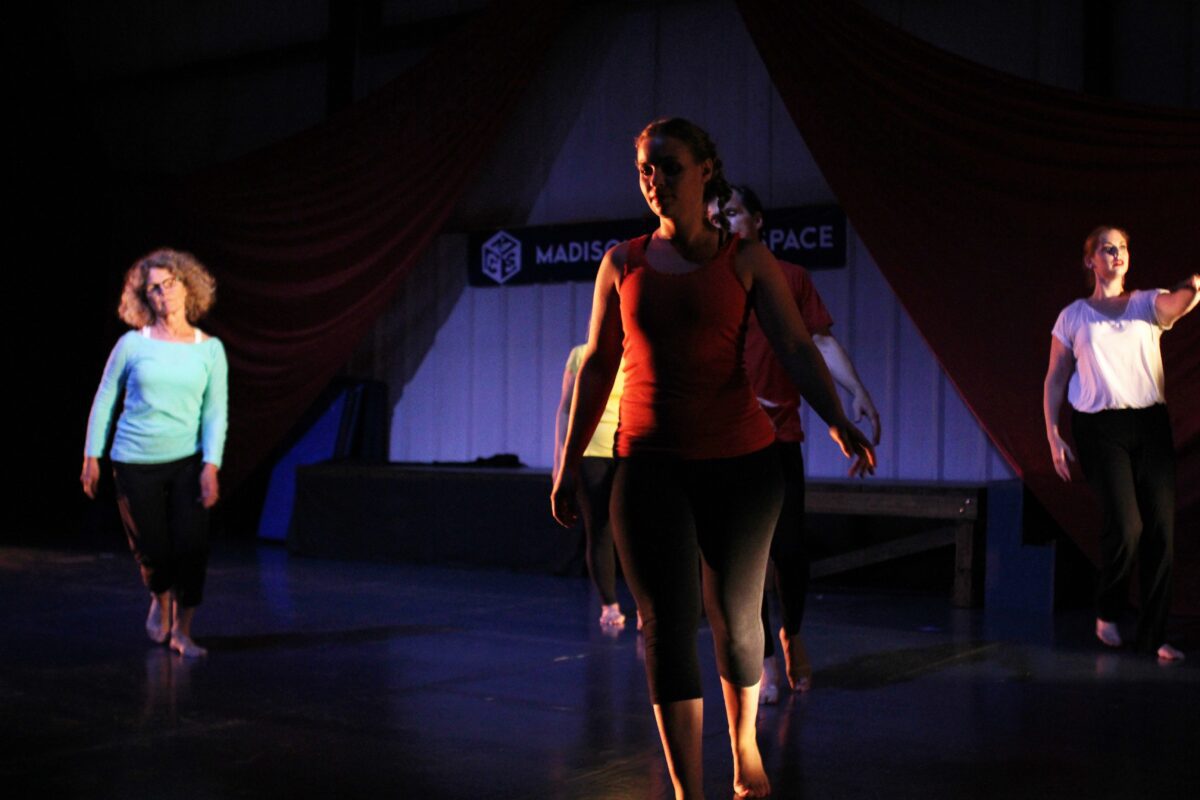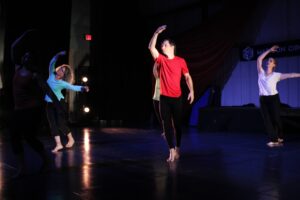
Google “dance” and you’ll find many photos of professional dancers and pint-size ballerinas. But what about adults who enjoy dance but don’t do it for a living? In addition to teaching dance to learners of all ages, the University of Wisconsin–Madison’s Division of Continuing Studies encourages them to perform at community events. The latest was MishMash, an evening of movement, comedy, and more organized by dance student Stephanie Richards. It took place August 19 at Madison Circus Space.
Richards and several of her classmates performed “Say Something,” a piece that explores their relationships with gravity.
It’s also a display of courage, according to instructor and choreographer Erica Pinigis.
“The dancers suspend themselves out of balance and have learned to control and direct the resulting falls,” she says. “Every time they do this dance, they are more daring in the way they use gravity and their relationship to the floor to accent their movement and musicality.”
Pinigis, a Kanopy Dance performer who recently moved to Madison from San Francisco, began teaching “Say Something” at the first meetings of Modern Dance 1 and 2 this summer. Students worked on it for eight weeks before sharing it with an audience.
The piece was a labor of love for both Pinigis and the students.
“It started out as a short movement phrase. We added a little bit to it every week as the students learned new concepts,” she explains. “Toward the end of the course, it was almost three minutes long, and you could see the dancers’ personalities in their movements. I saw moments of joy and soulfulness in what each of them was doing.”
Modern Dance student Jim Vogel had a few jitters before MishMash, but when it came time to perform, he tapped into the confidence he’d built in class.
“Erica is very knowledgeable, patient, organized, and fun,” he says. “I learned something new, and I dance more confidently because of her classes.”
Democratizing dance
Vogel took Modern Dance 1 and 2 to build his dance skills, get some exercise, and have fun in the company of others. Other adults enroll to express themselves, expand their artistic vocabulary, or simply try something new, says Jessica Courtier, director of Continuing Studies’ music and performing arts programs.

Credit: Jonathan Popp
“These classes are truly for adults. We want them to be accessible and enjoyable for anyone who wants to learn,” Courtier says.
This welcoming environment attracts a wide range of ages, skills, and body types. People who have never danced before learn beside seasoned dancers and those returning to the art form after a long absence.
Courtier says learners with physical limitations can benefit from dance classes, too.
“Our instructors know how to accommodate students with injuries and other issues that can make it hard to move a certain way,” she says. “They can show students how to modify the movements safely, and students can gain strength and flexibility.”
Dancing can even improve brain health, according to Pinigis.
“When you dance regularly, your brain benefits from new complex neural pathways,” she says. “Plus, you learn to look at the world in new ways.”
History in motion
Pinigis says workshops are an excellent way to try modern dance before taking a full-length course. This fall, she’ll teach two Dancing in Context workshops that explore important choreographers’ work and the cultural contexts that shaped it. They’ll also impart some of the movements that made these choreographers famous. The first workshop, José Limón and Revolution, Humanism, and Mexican Murals, takes place October 7. The second, Merce Cunningham and Chance, Technology, and the Avant-Garde, takes place December 2.
“The workshops are like labs where students can test out what they’re learning, see and feel their own growth, and access their artistry right away. They’re also a safe environment for asking questions,” Pinigis says.
In other words, these three-hour classes are a great fit for absolute beginners and experienced dancers alike.
Pinigis will also teach Modern Dance 1 this fall, beginning September 19.
“Learning modern dance is not easy, but it’s a lot of fun and has an incredible history,” she says. “Adventure and artistry await!”
For details about Continuing Studies’ dance programs, or to register, see this page.
Cover photo by Jonathan Popp.